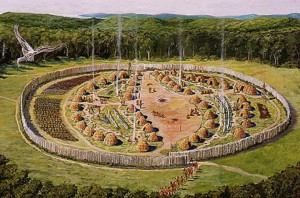Native American Population
Before European settlement, the native population between the Appalachians and the Atlantic was estimated at over 1 million*. By the time the Mahicans settled in Stockbridge in 1734, the Native American population in Massachusetts was all but gone. What happened? A losing battle against European pathogens and European land hunger.
Smallpox Epidemic
In 1617-1619 a smallpox epidemic had swept through the original inhabitants of Massachusetts wiping out – by some estimates – as much as 90% of the population. The only thing that might have spared the Native Americans of the Berkshires would have been their limited contact with Europeans.
This now sparse native population plus a Puritan commitment to christianize the Indians, kept relations largely peaceful until 1638 and the Pequot wars.
Early Peace Followed by Unequal War

By 1638 the English settlers (Puritan and otherwise) had found their way to what is now Boston, Provincetown, Long Island and New Haven. Despite the handsome fort pictured above, the Pequots were massacred by the combined English and Mahican forces,
Native Americans in the Berkshires Moved Back and Forth From the Hudson River Valley
By the beginning of the 18th century, fighting between Native Americans and Europeans was generally incorporated into wars between France and England with different tribes either choosing or being hired by different sides.
The primary tribe of the Berkshires was the Mahicans, Algonquin speakers that had made its home along the Hudson and Housatonic Rivers. They had lived by controlled woodland burns (to aid in the hunting of game), growing corn and squash, gathering edible fruits and nuts, and hunting deer and other animals.

They did not clear cut for stationary farms as did the Europeans, but they did have to move on from time to time as soil and game wore out. As with other tribes, they were attracted to the steel implements, pots, trinkets and guns of the Europeans and traded to obtain them. The Mahicans were often “middle men” between fur trapping tribes and the English and Dutch.
As noted in earlier posts, Native Americans had a somewhat different concept of property ownership than did the Europeans. They, particularly the Mahicans, considered the land theirs and thought it was only right to be paid for it. However, as far as the Native Americans were concerned, if the Europeans weren’t occupying an area, they could continue to use it.
The Mohawks (upstate New York – part of a five nation Iroquois confederation) generally sided with the French and were the enemies of the Mahicans. The Mahicans considered themselves go betweens between the Europeans and other peaceful tribes; but, if forced to choose sides, they would side with the English

Impact of Europeans on Native American Life
A number of elements of both the causes and outcome of the Pequot war would continue up to and through the era of the Stockbridge Indians.
- Despite decemination of the native population, due to disease, there never seemed to be enough land for the Europeans: in a conflict of cultures about land use the natives hunted and traveled over large, loosely defined and open territories; Europeans cleared, fenced and considered land they had simply taken or purchased to be for their use alone and in perpetuity
- Living side by side was challenging since the European domestic animals, as well as their clear cutting and plowing, destroyed Native American horticulture
- The population balance tilted to the Europeans with alarming speed: from 1620 to 1640 European population in Massachusetts is estimated to have gone from 90 to 14,000
- Although Native Americans started to acquire European weapons, warfare remained asymmetric. What we would call guerrilla war (and which served the colonials well during the Revolutionary War) remained the norm for Native Americans. These tactics (whether armed rifles or bow and arrow) worked well for raids and kidnappings but were no match for the disciplined lines of fire power employed by the Europeans.
- Like throwing a stone into a pond, spreading European impact changed both the relationship of Native Americans to their environment and the relationship of tribes to each other. As tribes shrank, some combined, some disappeared, and most would eventually choose a European ally (for instance, in the Pequot War the Mahicans who would eventually become the Stockbridge Indians fought with the English against their long-time enemies – the Pequots)
- Racism and over-reaction were at work. At best Europeans had the somewhat patronizing view that they were doing a service in saving the natives from their primitive spiritual beliefs and bringing them Christianity. At worst, as happened to the defeated Pequots, there were wholesale hangings and sale of the defeated into slavery in the Carribean.
Images: Pequot Fort at Mystic from Miner Descent WordPress Site , Pequot Museum, Mystic, CT.
“The Pequot War, ” Wikipedia, 2013
“Population History of the Indigenous Peoples of the Americas,” Wikipedia 2013
“History of Smallpox,” Wikipedia 2013
“A Century of Population Growth, the Colonial and Continental Period,” US Census Department
The Pilgrims of New England: A Tale of Early American Settlers, Mrs. Annie Webb Peploe, A Public Domain Book
The Mahican World, 1680-1750, Shirley W. Dunn, Purple Mountain Press, Fleischmanns, New York, 2000

The choice to proceed their studies in Front Finish, Back Finish, UI/UX, or iOS Improvement is entirely
as much as the students.
You will also have to consider buying such storage containers from
reliable sources. While buying kitchen appliances online you can simply compare products price, specification, features and reviews from ample
amount of sites. These kitchen waste bins, file holders and food storage containers come in a wide variety of types,
styles, sizes and colours.